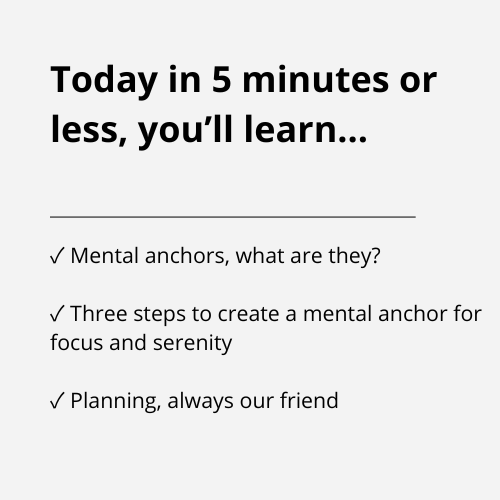- Verve Newsletter
- Posts
- how to manage study stress and keep calm during exams period
how to manage study stress and keep calm during exams period
Hello Enthusiastic of Knowledge,
The summer assessments are approaching, and end-of-semester exams are just around the corner.
I'm sure many of you are already beginning to study and plan ahead.
So, what better day than today to talk about how to stay calm and avoid stress during this time?

During exam periods, many students inevitably face various difficulties including the pressure to achieve excellent results, fear of failure, excessive workload, limited time, performance anxiety, and worries about the future.
In this newsletter, we will explore two effective strategies for managing stress in a healthy and productive way.

Mental anchors, what are they?
A rare yet incredibly useful practice that I have personally adopted is mental anchoring.
What are anchoring techniques?
Anchoring occurs when we associate a particular emotional or mental state with a physical gesture, so that every time we repeat that gesture, we enter fully into the associated state. These associations are remarkable when it comes to improving concentration.
Two years ago, I created one of these anchors by linking a meditative state of deep concentration, focus, and serenity to the gesture of touching the index finger to the thumb of my hands.
Even today, after years, I use this gesture before every study session or activity that requires calmness and concentration. Simply touching my index finger and thumb together for a brief moment immediately brings my body back to the state of deep concentration that I have associated with it.
The best part is that I use the same gesture before every exam or test that causes me anxiety, to calm myself instantly into a serene state, free from anxiety, where I am more focused and productive.
Exactly, in practice, every time I feel anxious, I join my thumb and index finger and immediately immerse myself in a serene state of focus.
Pretty cool, right? Today we'll see how you can create this association for yourself.
These associations can be created with any gesture and any mood, and they are incredibly useful tools. They are also simple to create, but they require a bit of patience and initial commitment.
So let's see how the process of creating these anchors works and how you can create one for yourself.
Three steps to create a mental anchor for focus and serenity
Firstly, there is the choice of the gesture to use as an anchor. I recommend something simple that doesn't require large movements. The reason I use a touch between the index finger and thumb is that it's a discreet gesture that I can practice even during oral exams and in front of others without being noticed. But you can choose any gesture you prefer.
Next is to immerse yourself in the state to be associated. This usually occurs through visualization or meditation. For our relaxation and concentration purposes, find a meditation of a few minutes that helps you relax your body, then relax your mind, and feel free from distractions. My practice involved imagining every part of my body from head to toe melting and relaxing. Once my whole body was relaxed, I began visualizing the colors of the rainbow from red to purple one by one, and when I reached purple, body and mind were perfectly relaxed. Once in this state of relaxation, I practiced the gesture of closing the index and thumb for a few seconds. After that, I released the gesture, stayed in the relaxed state for a few minutes before resuming the colors of the rainbow from purple to red, and finally opened my eyes. The entire practice takes 10 minutes.
Lastly, it's about practicing. Unfortunately, one-time practice is not sufficient for efficiency. To create an association, we need to repeat step 2 consecutively, once a day is sufficient, for 2 or 3 weeks. The key is to repeat the association of mental state and gesture, mental state and gesture, mental state and gesture until the gesture and mental state become the same thing. At that point, only by repeating the gesture will your body immerse itself in the mental state.
To create a solid anchor, usually, 21 days of practice are necessary. 21 days because it's the average time needed to form a habit. Actually, it depends from individual to individual; some take less time, others more.
The most concrete way to understand if you can stop the practice is when you simply notice that by repeating the gesture, you feel your body automatically sinking into the mental state you practiced. From there on, every time you repeat the process, you'll strengthen the anchor, making it stronger day by day.
This practice isn't immediate; however, it's worth investing 10 minutes a day to create this association and use it for life.
After those three weeks spent practicing, I am incredibly grateful for having done so, and only now, after using this gesture thousands of times in any stressful situation I found myself in, do I truly understand its importance.
Gift yourself the creation of this association as soon as possible because you'll never regret it.
Planning, always our friend
The second, most common, and effective practice during exam periods is undoubtedly planning.
Planning our study allows us to determine how much time we need to dedicate each day to reach the desired level of preparation.
Moreover, the most significant benefit is that it helps us manage the stress associated with limited time pressure. With good planning, we have a concrete daily goal to achieve, without having to think about the entire exam's complexity and all the topics we need to study.
Additionally, creating a realistic study schedule that includes regular breaks and time for relaxation and self-care activities is essential. Plan time to engage regularly in physical activity to reduce stress and improve your mood. Even a short walk or a yoga session can help alleviate tension and enhance concentration.
If you want to save time in planning and create an easy-to-follow and effective study plan, this is precisely what you need.
For this exams period I launched my Exams Organization System: Achieve Your Goals with Step-by-Step Guidance and Time-Saving Template
The Exams Organization System is a specific exam planning system that provides a clear and detailed structure for planning exams step by step, thus eliminating the need to learn how to plan from scratch and saving valuable time.
It helps avoid follow-up issues by providing an effective and practical method for organizing exams and achieving desired goals.
I created this template for myself, based on the most effective planning principles, and it has become my faithful companion for planning not only study sessions but also every learning goal I set.
With this system, you will save an enormous amount of time, keeping everything you need to study day by day under control and avoiding the feeling of not knowing what to do. Additionally, by easily tracking your progress, you will increase the chances of reaching your goals without distractions.
All you have to do is open the template and start planning, and in just a few minutes, you will have the study plan for the next month of exams ready.
The available templates for this month are only 5.
Considering that this newsletter reaches 1800 people, if you're lucky enough to see this offer first, visit the Exams Organization System immediately.